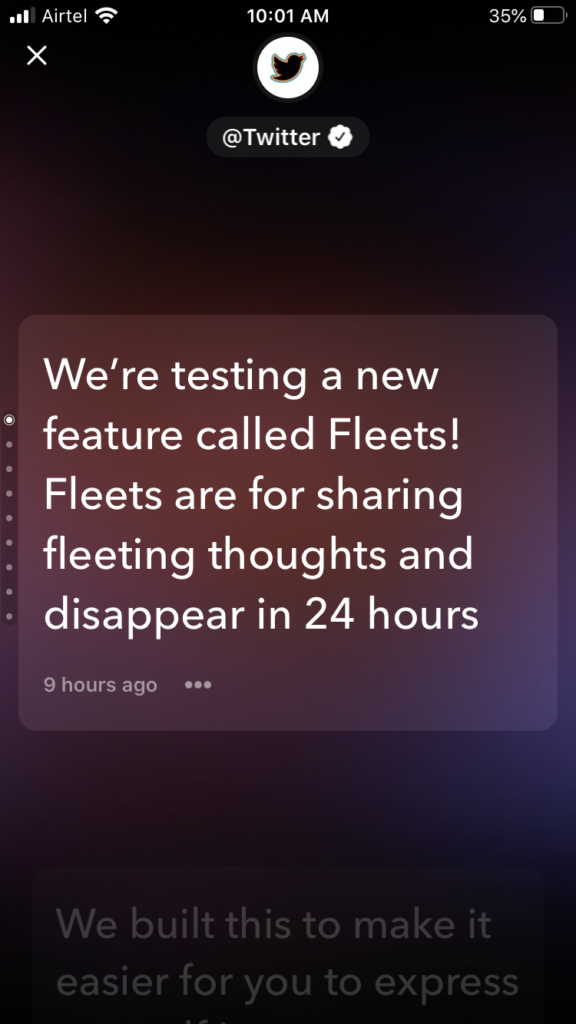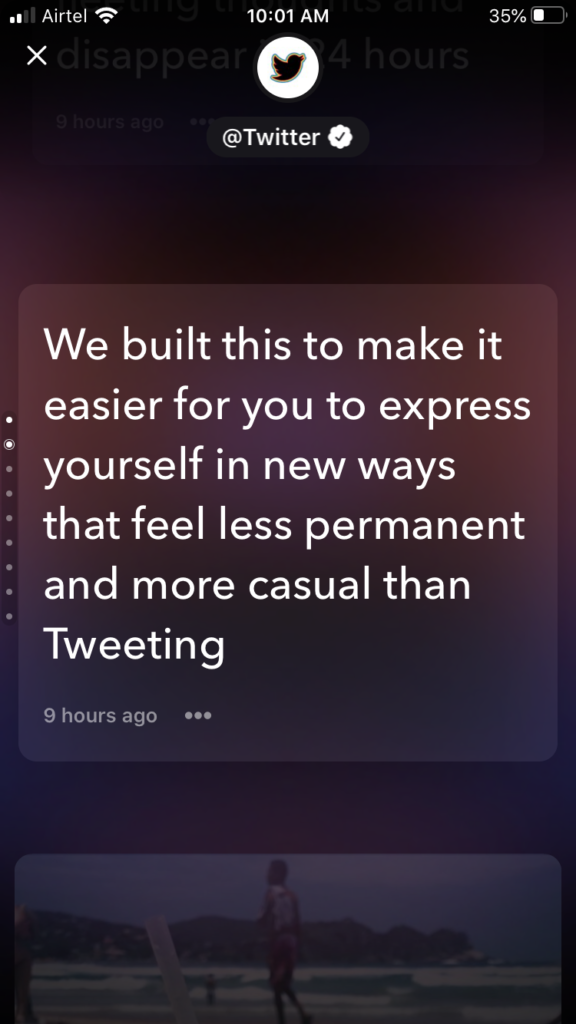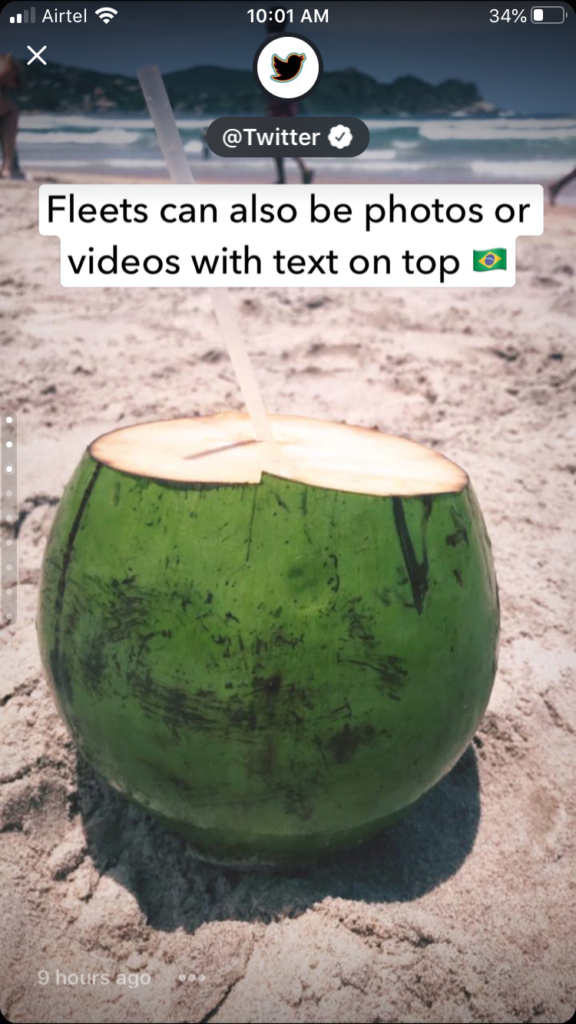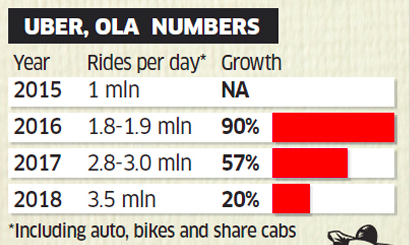- The Black Swan – Nassim Nicholas Taleb (Apr-2020)
- Fooled By Randomness – Nassim Nicholas Taleb (Apr-2020)
- How Will You Measure Your Life – Clayton Christensen (May-2020)
- The Happiness Hypothesis – Jonathan Haidt (May-2020)
- Range: How Generalists Triumph in a Specialized World – David Epstein (June-2020)
- The Inner Game of Tennis – W.Timothy Gallwey (July-2020)
- Junto Session on Strategy (Aug-2020)
– Good Strategy, Bad Strategy
– Playing To Win
– 7 Powers
– Understanding Porter
– Thinking Strategically - Junto Session on Autobiographies (Sep-2020)
– Open
– Shoe Dog - The Psychology of Money -Morgan Housel (Oct-2020)
- Siddhartha – Herman Hesse (Nov-2020)
- Recap of Books Discussed in Previous Sessions (Dec-2020)
- Letters to a Young Contrarian (Jan-2021)
- Obviously Awesome – April Dunford (Feb-2021)
- Confessions of an Advertising Man (Mar-2021)
- Junto Session on Stoicism (Apr-2021)
- Thinking Fast and Slow (May-2021)
- Coffee Can Investing – Saurabh Mukherjea (June-2021)
- Storyworthy – Matthew Dicks (July-2021)
Category Archives: Uncategorized
Twitter’s Fleets and How Stories Ate The World
Earlier this week, Twitter rolled out their stories feature (called Fleets) in India. While Twitter first rolled out Fleets in Brazil in March-2020, India is the third market (Italy being the second) where the feature is now available.
What are Fleets and how do they work?
- Fleets, as they are called are text/picture/video updates that last for 24 hours.
- Available only on mobile clients for now, they show up rather on top of home feed rater inconspicuously.
- Fleets can be replied by mutual followers (friends as they are called) or if the creator has their Direct Messages open.
- Fleets can‘t be retweeted, won’t show up in search and can’t be embedded on external sites.
Stories are the new Feed
While they might seem like a not so old addition to the world of Social Networks, Stories were first introduced by Snapchat in late 2013.
For Snapchat, stories was a dream feature which was off to terrific start and became their most popular feature eclipsing snaps within 8 months of its launch. In April 2014, 500 million stories were viewed in a day and that number doubled to a billion stories viewed per day by June 2014. Snapchat DAUs grew from less than 40 million in Oct’13 (when stories launched) to 153 million by Oct’16.
Below is a short video by Evan Spiegel explaining Snapchat, it also covers briefly what stories are, ‘They are a collection of snaps from a day, in chronological order, this is different from a feed in most social media networks which are in reverse chronological order’
While Snapchat had a clean runway for almost 3 years with stories, its success caught attention of their biggest competitor Instagram which blatantly (but rightly so) copied and launched stories in Aug 2016.
Instagram Stories became a massive success. Just two months after its launch, it had 100 million daily active users, a number that doubled to 200 million by April 2017 and 250 million by June 2017, figures that dwarfed Snapchat’s 166 million daily active users. — Wired (2018)
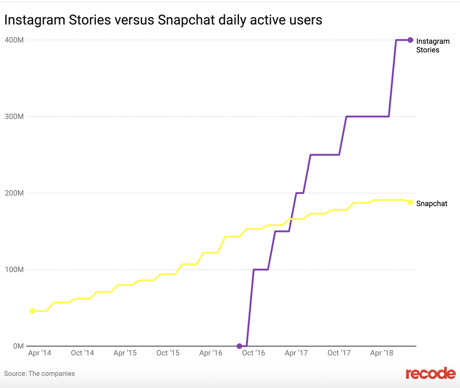
The power and future potential of stories (and desire to stall Snapchat’s growth) was not lost on Zuckerberg, who launched an all out attack against Snap by integrating stories on all their products starting with Instagram (Aug’16), followed by Facebook Messenger (Sep’16), Facebook App (Jan’17) & Whatsapp (Feb’17).
After trying at least half a dozen times to steal Snapchat’s thunder, stories did the trick. By Early 2018, each of facebook’s products had more DAUs than Snapchat
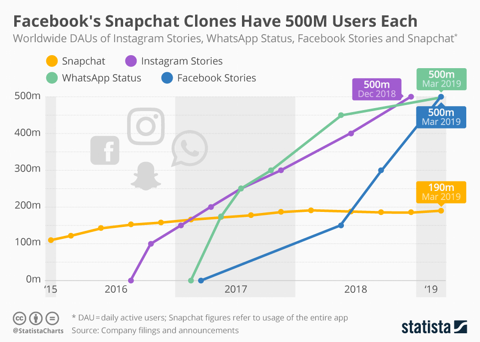
Stories are Eating the World
For the first 2.5 years or so since they first appeared, Stories went largely unnoticed but that changed after Facebook integrated them in their portfolio apps.
- Proliferation of stories across the web: Soon after the success of Snapchat & Facebook, every social media/content/messenger was trying to integrate stories.
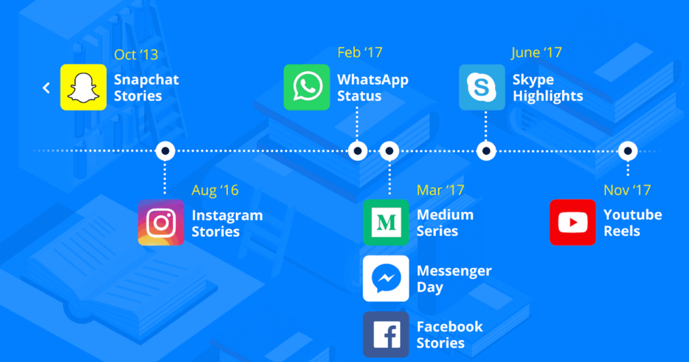
Like most things in life, blindly copying doesn’t always work. Skype rolled back it and Youtube stories never really took off. The reasons for it not working could be vastly different in both these cases
2. Stories Everywhere: While more and and platforms were trying to incorporate stories format for themselves to increase content creation and more user engagement. Snapchat decided in Apr’19 to allow stories to go beyond their walled garden by launching ‘Stories everywhere’. They later enhanced it further by having ‘App Stories’, powered by Snapkit, to be posted to over 3rd party apps such as Hily, Triller & Squad.
Perhaps, this could be a trend which Facebook and others also follow
As of today, Stories are a primary way in which users share, consume and engage with content across different apps. There’d would be around 1.5 billion users around the world that create or engage with stories.
The Beauty of Stories
As of today, Stories are a mainstay in the online ecosystem with varying degrees of success. Let’s take a look at what makes stories tick.
The stripped-down format of Stories offers users the ability to share what’s happening or what they are thinking in the moment in a raw, authentic way . This gives users an opportunity to move away from the need to carefully curate their posts.
- Low Bar — The amount of content a user shares on social networks is primarily dependent on its quality and if they’d want it to be there on their profile/feed permanently. The quality of content determines the engagement (validation) which puts some pressure. By having posts that get deleted in 24 hours and don’t show engagement stats publicly rids the users of any pressure and lowers the bar on what content get shared.
- Shift to Photos & Video — A picture is not only worth a thousand words but also easy to take and consume. With the proliferation of smart phones and mobile internet, more people across demographies got access to internet. Also, the preferred type of content for consumption moved away from Text to Photos & Videos. Apparently, videos consumption is nearing 45% of overall consumption. Stories are a great way to build upon and leverage this trend.
- Ease of Creation & Added Effects — Whether it’s Instagram or Whatsapp, creating stories is really easy and most apps support additional features such as filters, gifs & polls to enhance the appeal of stories by making them look fresh and interactive.
- Access: In most apps, stories appear on top of users feed making it easy to access without compromising their feed. While by design feed users would be lower than app users, this pull based approach ensures higher engagement among stories users as they more motivated. This also ensures, that users don’t have to worry about spamming their friends feed by posting 7 updates in 30 minutes.
- User Experience: The experience of scrolling through multiple user stories is extremely neat. You can skim through the stories in a go, skip some, resume them later and engage with them. The fact, that the responses to users inbox ensures privacy that further removes friction. With stories (unlike post on feed), no one knows who is responding to whom. Given the lightweight and low bar on creation, stories ensures the variability in rewards (what would come next?) which leads to habit creation.

Twitter & Fleets:

But, this seems to be changing now. During Q1’20, Twitter registered highest increase in their DAUs in the last 5 years.
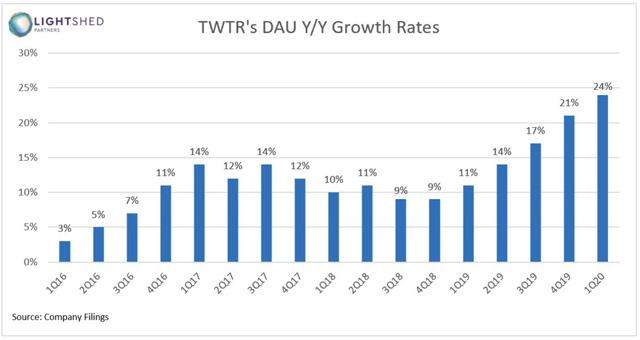
While user growth is great, a core problem for Twitter is monetizing its users. During Q4’20, their revenue growth was only 11% against user growth of 21%. While Twitter has been actively trying to fix this, with the release of Fleets there’s a good chance of this happening.
Better Ad Monetization via Fleets
For all the (small but) premium audience Twitter attracts, it’s ability to monetize them isn’t even half as good as Facebook.
I spend 5X the time on Twitter as compared to all other social media sites combined but I can hardly remember being targeted by a relevant ad. It’s that scarce. Similarly, when it comes to running campaigns, Twitter never got to the consideration set in most app install I’ve done, seen/heard about.
(Big Audience -> Data Collection -> User Profiling -> Ad Targeting -> UX to drive installs/transactions) * Repeat
All of this has been a challenge but Fleets could just be light at the end of this tough path to better monetization.
The Opportunity:
- Increased Surface Area — By having updates that get deleted in 24 hours and don’t appear by default in your followers timeline, Fleets increase the surface are of their users social media postings. While earlier, If I had to post picture of my meal or new purchase I had no option but to go to Instagram, Snapchat etc to post as I felt that pic didn’t belong to Twitter. But with Fleets, that changes. Like my, for many users their share of social media time is likely to tilt towards Twitter.
- Higher Engagement — Over time once it picks, users should post same or more fleets than tweets which implies more time spent, data collected & engagement among other users.
- Shift to Videos & Images — This is really interesting, away from the land of majority text updates in a feed, stories offer a more visual and focused experience, which is better suited and contextual for advertising (esp. App Installs or even commerce)
While I’m quite bullish of Fleets being a great addition to Twitter and wait to see how things unfold, I’d love to know what do you think.
Corona Virus (Covid-19) is now a Pandemic.

I first shared my apprehensions about the breakout of Corona Virus today morning in a post and the past 12 hours have been quite eventful already.
Global
India
- India has suspended all existing visas except diplomatic, official, UN/International Organizations, employment, project visas till 15th April 2020.
- All incoming travelers (to India), including Indians, arriving from or having visited China,Italy,Iran,Republic of Korea, France, Spain & Germany after 15th Feb, 2020 shall be quarantined for a minimum period of 14 days.
Rest of The World
1) Italy’s confirmed cases count has crossed 12,500 (2313 cases in a single day) and 800 deaths (196 deaths in a single day)
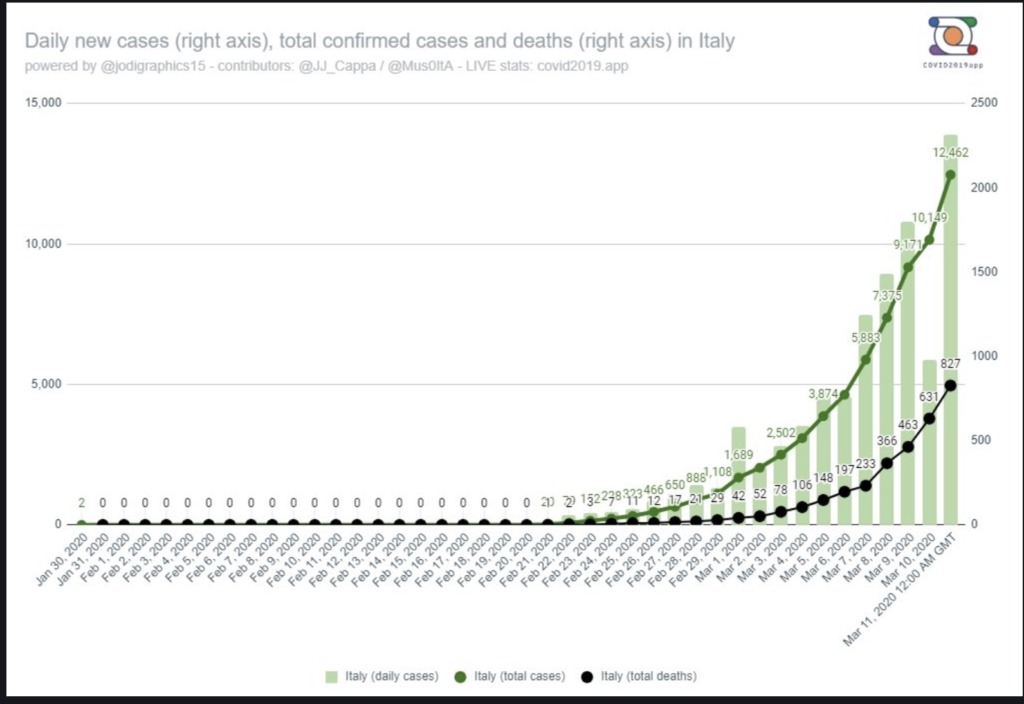
Covid-19 Outbreak – Do You See The Risk?
During the SARS outbreak (2002-03) I was in engineering college and have no memories of it. Also, TBH I don’t remember much about the deadly Swine Flu which killed over 200,000 people worldwide.
If I think about it, I guess having not to read/think about critical events like these isn’t all good as it could lead you to underestimate their severity.
As I write this post, Coronavirus cases worldwide have crossed 115000 and has killed over 4200 people. As per WHO, Covid-19 is close to a pandemic
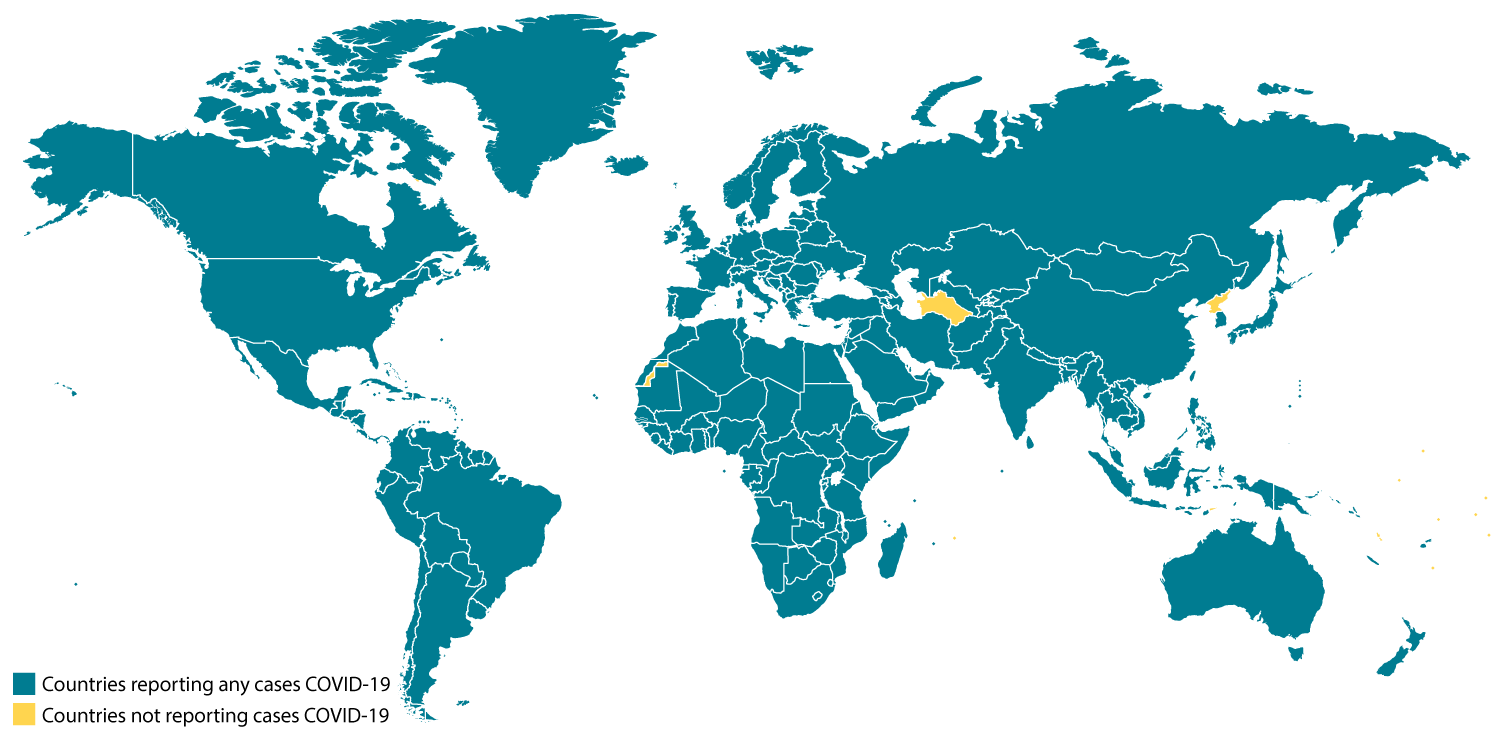
The count of confirmed cases in India stands at 62 as of 10:20 AM today. (2 deaths?)

It is anybody’s guess on how this graph would look from here.
PS: It would be fair to assume the actual numbers are significantly higher

The gif above conveys that bulk of the damage from COVID-19 can be avoided if we are able to spread out the occurrence of confirmed cases just around the capacity of our healthcare systems to handle. Anywhere in the world where that hasn’t happened has lead to massive damage to human life (Earlier Wuhan and now Italy).
No one would argue that health care infrastructure of India is capable to handle a massive outbreak like Wuhan (or Italy) and knowing the innumerable inefficiencies in our systems it is super scary to think how easily things can turn out of hand.
Some of the steps the government is taking to prevent an outbreak
- Increasing Testing Labs (52 as of now)
- Closing Schools, and Colleges (Kerala has also ordered restrictions on Public Events Cinemas too, so has J&K)
- Increasing Screening at Airports, Advising on Self Quarantine and Suspending Visas to affected countries (8 countries so far)
- Having Awareness Messages as Ringtones
- Kerala Govt is working on Increasing bandwidth and Improving internet connectivity.
While government is doing it’s bit (and we can debate how effective they are at it), what might be more important for us is what we do to stay safe.

Why Worry?
- 20% of confirmed cases have severe infections, 10% require ICU admission and up to 4% can die. Read here
- With SARS and MERS survivors are reported to have had long term respiratory issues. Read here
- Each new case infected 2.5 other people on average in the early stages of the epidemic. Read here
- No Vaccines for the disease and are likely to be available by early 2021.
- Re-occurence is possible. There are reports of people treated getting infected again
“Individual precaution does not scale to collective precaution…. Hence one must panic individually in order to avoid systemic problems.” – Nassim Taleb.
I feel super anxious these days, maybe because I have old parents and a young kid, or maybe it’s just me being me.

I guess the standard bell curve distribution holds true in this case too. While a smaller percentage would either be operating with minimal concerns/precautions as if nothing has changed (Holi toh khelenge hi) or taking extreme measures to stay safe, the majority would be split between worrying about the spread of virus and trying to make a living/lead normal life.
At a personal level, I’m trying to make a switch from B to C to the extent possible.
(Avoiding malls/gym/metros to begin with) and desperately trying to convince rest of my family.
Things we can and must do
- Convince ourselves that the risk is real. Read this
- Avoid crowded places
- Ensure personal hygiene
- Try to reduce exposure to unknown people. places
- Wear Masks, Use Santizers
- Stock up essentials?
While this might appear as fear mongering or unnecessary panic to some, the way I’d like to think here would be in terms of Unforeseen Risks.
Risk is complicated, which is why we’re not great at dealing with it. It’s more than just something bad happening. How risky something is depends on whether its target is prepared for it.
“Risk is what’s left over when you think you’ve thought of everything.”
Additional Reads (Will keep updating this list)
Short Reads
Long Reads
- Systematic Risk of Pandemic
- Why Does Soap Work So Well on Viruses
- Understanding pandemics: What they mean, don’t mean, and what comes next with the coronavirus
- FAQ’s by Harvard Health
Videos & Podcasts (Will Update Soon)
2019: Looking back at the year that went by
Tis the Season of Reflection.
As the year draws to an end it is the perfect time to reflect on the learnings and share them. Here are my key learnings turned guiding principles from the year that went by
Guiding Principles of 2019
- Live in the present
- Become Better Everyday
- Make Concentrated Bets
- Increase Optionality
Live in the Present

A friend once told me “Unhappiness comes from Conflict“, simply put, when you desire X but are stuck with Y. While we all want multiple things to happen/get better simultaneously, the only way to stay peaceful is to accept your present situation and adjust your life around it.
Our lives are made up of multiple phases across dimensions of family & friends, career and personal life that are ever changing. Each phase would have a few key events that would lead to highs/lows across different dimensions.
All phases of life give you an opportunity to focus on some aspect/dimension of your life and it’s best if we use that time to do just that, focus on what’s right in front of us (and not fret too much about the rest).
A good question to often ask yourself, “What should I be optimizing for?”
I cut down on reading, movies, travel, socializing etc and 2019 for me was about mostly focusing on the new baby and the new job.
Become Better Everyday
Successfully Implemented by Dave Brailsford & popularized by James Clear, the idea that tiny changes sustained over a period of time compound massively.
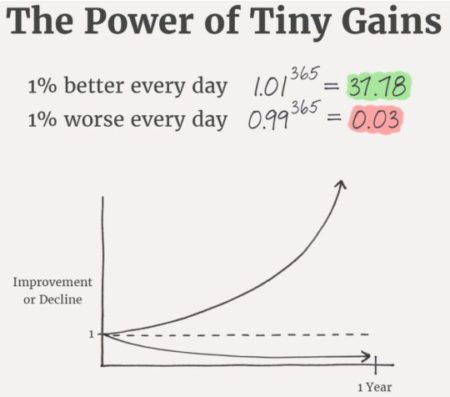
The whole principle came from the idea that if you broke down everything you could think of that goes into riding a bike, and then improved it by 1%, you will get a significant increase when you put them all together – Dave Brailsford
The power of compounding married with the fact that there’s as much (if not more) life ahead of us as is behind builds a really strong case to become a much better version of yourself. Bonus, being better improves lives of others around you.
I tried to follow this rule and ensure that I make almost every day count by exercising (Cult, Ahoy!) / writing / learning something new.
Make Concentrated Bets
While conventional wisdom says that diversification is the key to investing success, some of the best investors, like Warren Buffett & George Soros have spoken about the virtues of making concentrated bets.
Wide diversification is only required when investors do not understand what they are doing – Charlie Munger
Be it investing, career or relationships, most gains are to be made by focusing on few things and giving them all the effort (think Power Law). I’ve seen quite a few people trying to spread out too thin and not achieving anything substantial. I feel it makes sense to focus your energies on limited ideas & people and double down on them
Caveat: Avoid Ruin
PS: It’s quite likely that investing more time/effort on your career/startup will yield bigger returns than stocks/mutual funds etc.
Increase Optionality
Optionality in investments refers to the right to do something, but not necessarily the obligation to do so. Just like in investing you can build optionality into your life and exercise them for better outcomes. Collecting high-quality options is the equivalent of unlocking doors that open up to new possibilities.
While on the surface this might look conflicting to the above mentioned point of being concentrated, in reality they work best together. Optionality in asymmetric bets (limited downside, high potential upside) across domains can be built with just small % of resources (time/money etc).
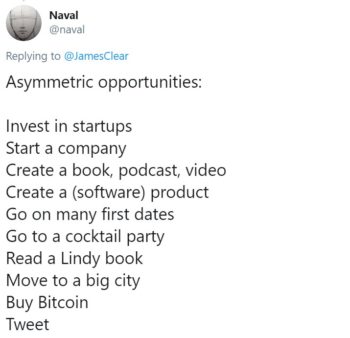
Few things I did to increase optionality
- Meet New People & reconnect with old acquaintances – Increases Serendipity that opens up opportunities
- Take up chances to expose myself to new ideas & experiences – Gives you new perspectives that might have a big impact
- Watch my Spends & Avoid Debt – Better personal financial management enables risk taking/bigger bets
- Being conscious about & working on my health/fitness – Better health allows you more freedom of choices in certain areas of life.
Wishing you all a wonderful and enriching 2020 🙂
Capital ROI of various Indian Startups
The tide has been trying to change for sometime now, from Growth at all costs to Profitability & Sustainability. Recent Tech IPOs in US reflected the same and made things pretty clear.
While Uber & Lyft’s abysmal IPO sustained the push to margins and profitability, explosion of WeWork was the final nail on the coffin.
Since the relatively nascent Indian startup ecosystem is a reflection of US & China (in some aspects), one can expect to see a stronger push for Margins/Profitability in India as well.
I tried to collate a view from all publicly available data on revenue and losses for various Indian Startups to get a view of what’s happening. Hope you’ll find it useful too.
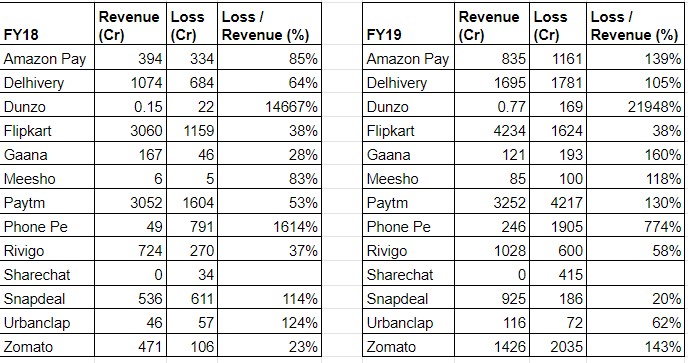
As more Indian Startups file their earnings for Financial Year 2019, more data will emerge. I’ll try to update this view.
Living Life in Single-Player Mode
I am a huge fan of Shane Parrish’s podcast and one of best episodes from it was with Naval Ravikant. Naval shared a lot of awesomeness in it and one of the things that stood out for me was the thought of looking at life as a ‘Single-Player’ Game
Life: A Single-Player Game
The reality is life is a single-player game. You’re born alone. You’re going to die alone. All of your interpretations are alone. All your memories are alone. You’re gone in three generations and nobody cares. Before you showed up, nobody cared. It’s all single-player. – Naval Ravikant
While talking about transitioning from anger/anxiety to calmness and how to control one’s responses or mental-state, Naval mentions how most people are conditioned to live life in a multi-player mode wherein the things that we chase are the visible social status and other such indicators.
Subsequently, the key to being happy is to get rid of yearnings for visible status indicators and focus on your internal state.
Socially, we’re told, “Go work out. Go look good.” That’s a multi-player
competitive game. Other people can see if I’m doing a good job or not. We’re told, “Go make money. Go buy a big house.” Again, external monkey-player competitive game. When it comes to learn to be happy, train yourself to be happy, completely internal, no external progress, no external validation, 100% you’re competing against yourself, single-player game – Naval Ravikant
Naval drives home the point really well. Instead of chasing external progress, we’d be better of chasing internal progress.
Life in Single-Player Mode
While, the points mentioned above, are mostly about taking care of your mental state, focusing on being happy and such, I’d like to extend the idea of life as a ‘Single-Player Game’ to living life in a ‘Single-Player Mode’
A single-player game is usually a game that can only be played by one person, while “single-player mode” is usually a game mode designed to be played by a single-player, though the game also contains multi-player modes – Wikipedia
Approaching life in a Single-Player Mode in essence means leading life in a way that assumes complete responsibility of own’s actions and their effects, and also encourages proactive self-improvement sans any dependancy on others.
What does Single-Player Mode Look Like?
Let me illustrate the point by taking some examples
Sports/Fitness: Say you want to become better at a sport. There are two ways to go about it
1. Multi-Player Mode. In a multi-player mode, you’d try to find someone to play/work out with (or find a coach) and practice with them to improve your game.
2. Single-Player Mode. In a single-player mode, you’d not limit your practice and improvement to finding & playing/working out with others. Either-ways, you’d find ways to practice and thereby improve your game/fitness.
Work/Skills: Say you want to become better at your job or pick up a new skill. Again, there are two ways to go about it.
1. Multi-Player Mode. In a multi-player mode, you’d try to find someone to learn from/with and depend on them for your learnings
2. Single-Player Mode. In a single-player mode, you’d not wait to find someone and instead try to learn and pick up skills on your own.
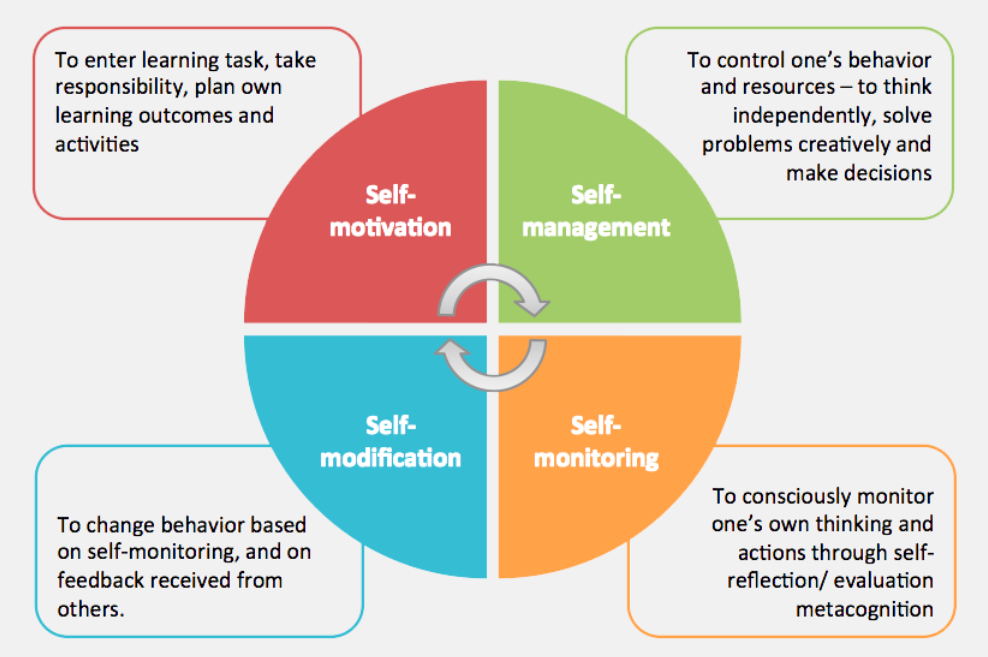
More often than not, whenever I’ve become good at something it’s because I approached it with a ‘Single-Player Mode’. Letting go of dependency on others for your learnings removes a lot of friction. Not only that, it shortens the feedback loop (and their-by improving the pace of learning) and lets you decide your own goals and metrics.
To top it all, Operating in a Single-Player mode requires that one figures out ‘Learning How To Learn’. Finding out how to learn different stuff on your own is quite transformational or should I say life-changing.
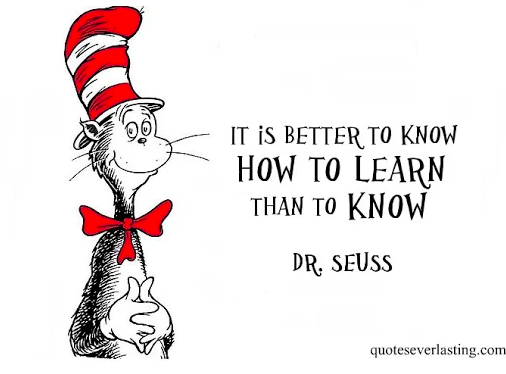
Another way to live in ‘Single-Player Mode’ is to compete against yourself. Here again you have to look internally to get better. It might take a while to get this engine started but once it starts, it works marvellously

If you look around, almost all super successful people operate in Single-Player Mode. They don’t really depend on others for motivation, inspiration or figuring out how to learn/get things done.
To conclude I’d say, if there’s something you’ve been trying to learn (coding, foreign language etc) or start doing (running, gymming, diet control) you’d be better off if you approach it in a Single-Player Mode
The Transportation Layer Protocol of Business
In his classic WSJ piece from 2011, Marc Andreessen declared that ‘Software is eating the world’.
Seven years hence, things are unfolding as Marc had prophesied. Industry after Industry, software is re-writing the rules of how the game is played.

Transportation has been one of the few industries that have already seen a lot of Schumpeterian “Creative Destruction”.
From being ‘Limo service for wealthy people in SF’ to ‘Ride sharing for commoners in Bangladesh’, Uber and many other software based transportation services have come a long way. Goldman Sachs estimates the ride-hailing industry ballooning to $285 billion by 2030.
A host of startups around the world are working in the transportation space with Uber, Lyft and Didi being the bigger players. The Indian Market is also seeing a lot of action in this space.

While the pure transportation market is huge, there’s an sizeable adjacent market (roughly 1/3rd the size in terms of orders) growing at a faster pace. The market in question is ‘Food Delivery’
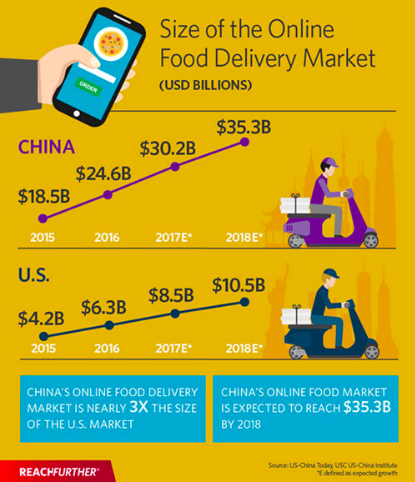

Apart from Swiggy and Zomato, there’s Foodpanda, Uber Eats and two more big players starting Food Delivery over the next 3-6 months.
Challenges for Ride-Sharing & Food Delivery Startups
Both Ride-sharing and Food Delivery startups are the epitomes of gig economy and have unlocked huge markets that were previously untapped.
However, to make some economic sense for both types of companies have to make sure that their delivery staff runs at highest utilisation possible.
But, because of the inherent nature of both ride-sharing and food delivery markets, the orders are concentrated at certain peak hours of the day.

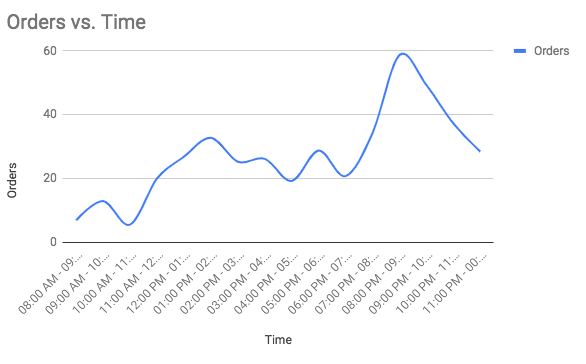
Ride Sharing Peak Hours*: 8AM – 12 PM, 5 – 9 PM
Food Delivery Peak Hours*: 12PM – 4 PM, 8 – 11 PM
*Rough Estimate
This cyclicality in demand means there are upper limits to optimisation during peak hours and there are long windows of low demand
These long windows of low demand are a huge problem as they lead to
1. Poor Unit Economics (To cover fixed costs the delivery boy should be utilised fully)
2. Weaker Driver Retention (Part time gig workers will gravitate towards a service that guarantees opportunities to earn more)
3. Scaling Challenges (Uneven/Skewed demand during certain hours makes it difficult to scale delivery ops in an optimised way)
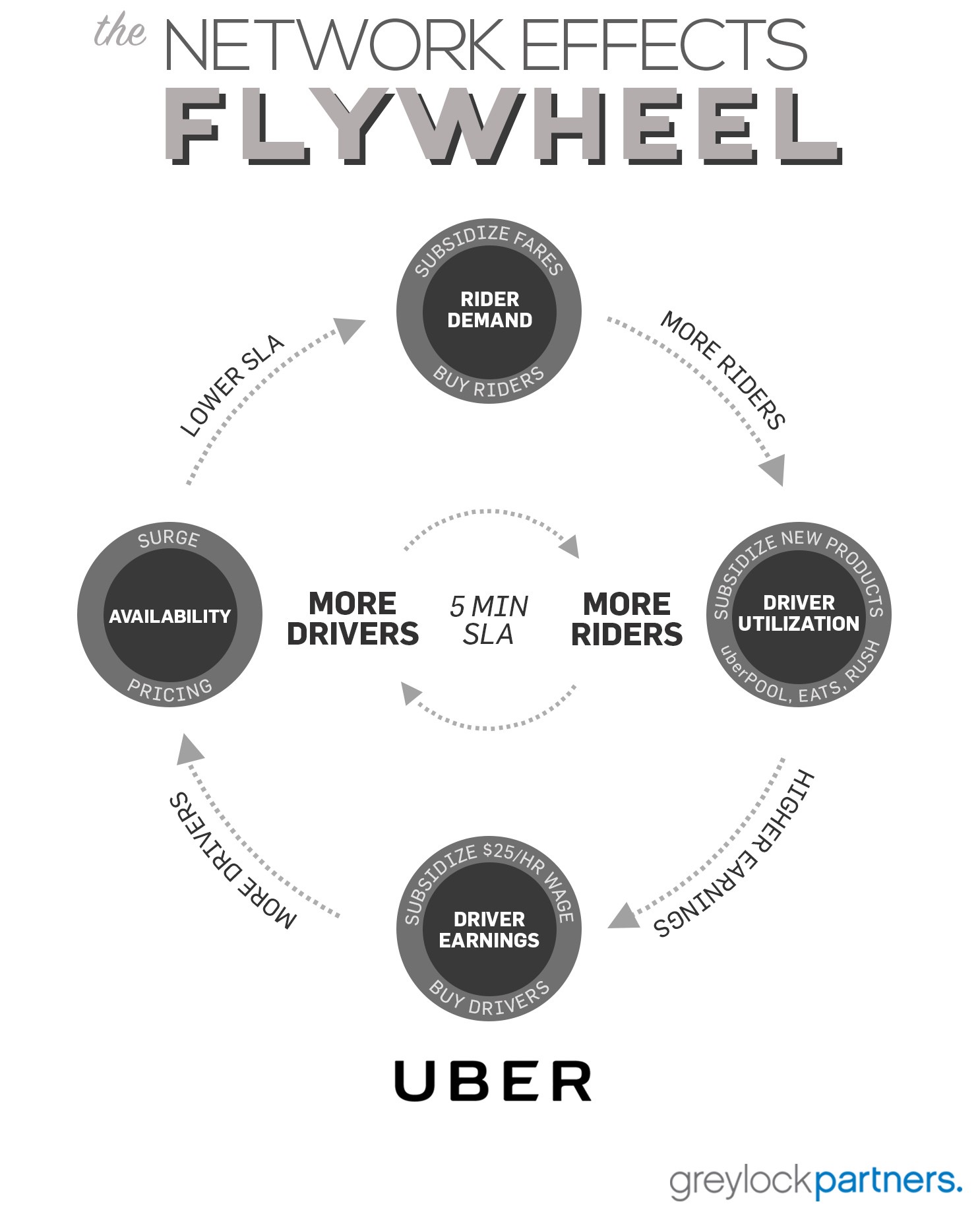
Less Demand => Poor Driver Utilisation => Poor Driver Retention => Poor Experience => Less Demand
These problems are pronounced for and particularly hurt the food delivery services, that’s also one reason why most of the ‘stand-alone food delivery’ startups found it difficult to get off the ground and ended up folding. While most startups offering logistics services in Hyperlocal/Food-Delivery space trying defeating gravity and failed, Delhivery (with benefit of hindsight) was able to identify the challenges well in-advance and did a pivot into e-commerce deliveries that offered better fleet utilisation opportunity among other benefits.
The Case for a Transportation Layer Protocol
Both Ride-Sharing and Food-Delivery startups not only share common challenges around fleet capacity utilisation, they also to varying degree share some strengths
- Huge Captive Customer Base
- Network of Drivers across cities
- Scalable Technology Stack for Managing Logistics
- Proprietary Data about People, Businesses, Routes, Traffic etc
- Operations Infrastructure
Protocol: A set of rules and guidelines for communicating data

The Internet Protocol Stack enabled various web applications to be built on top of it and a handful of them grew up to become today’s Internet Giants (Facebook, Google, Amazon).
Just like the internet protocol layer enabled various apps to be built for the web, we can see a bunch of startups trying to build what can be called ‘Transportation Layer Protocol’ or ‘Transportation Layer’

The Transportation Layer implies having a base infrastructure to build various consumer (B2C) or business (B2B) offerings on.
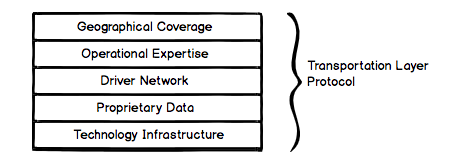
Most companies in this space end up building different variants of Transportation Layer Infra for internal consumption. But to leverage it and attain a dominant market position (with a sustainable business model) the startups should/would try to become the ‘Transportation Layer’ for the country.

Ekart Way*: Just like Flipkart’s logistics arm also handles logistics for other companies such as Adidas, in future some of the B2C companies discussed here might also start doing deliveries for other restaurants (managing the delivery orders a restaurant gets directly).
A startup can run multiple lines of businesses on top of the common infrastructure & generate adequate customer demand for their offerings
— A Successful Transportation Layer at Play
Becoming the default app for any transportation related services is the ‘Holy Grail’ as you get both more transactions and revenue per user and it costs you less to service each request. Also, the bigger you become the network effects ensure that less likely you are to get displaced.
This, I believe is what’s unfolding in India and startups from both sides (ride-sharing and food-delivery) are vying to become the ‘Transportation Layer’ to services various consumer offerings.

Expansion to Adjacent Markets:
- Ride sharing Startups – Both Uber and Ola (Foodpanda) have been doing food delivery for around an year now.
- Food Delivery Startups – Swiggy has shared their plans of expanding into Grocery and Medicine Delivery.
- Grocery & Medicine Delivery Startups – I Don’t think the grocery delivery startups have shared any plans for other categories.
- Concierge Startups – Dunzo, has started doing bike taxis, food delivery and grocery

The image above you should give you some sense of what the fruits of becoming the default transportation/logistics layer would look like with different B2C/B2B offerings stacking up atop shared demand and infra.
However, while getting there might be possible it’s gonna be incredibly difficult. Moreover, despite the number of startups aiming, only a few market players are strongly positioned to get a good crack at it. I’ll try to explore more in another post
Best of the Web 102
Toy Markets, EU is Furious with Malta, Decision Making, Instagram Story ,Where’s Larry Page, Malls 2.0 & More
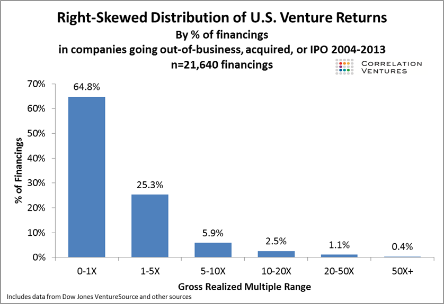
While Alphabet faces existential challenges, its co-founder is exercising his right to be forgotten. Read more in Bloomberg’s “Where in the World Is Larry Page?“
Dated but very interesting. “Why I would never want to compete with Travis Kalanick” by Chris Sacca. Read here
Founders often don’t innovate because they can’t quite figure out the answer to “How big could this get?” Read more on how to think and navigate the market size aspect here #YCombinator
The union’s least-populous member nation has become a cryptocurrency and online gambling hub plagued by allegations of corruption and money laundering.Read more in “Why the EU Is Furious With Malta“
Rewind (Best of newsletter #68)
“As they re-invent themselves, malls in India are trying to become community spaces and not remain just shopping centres.” Read more in “The mall story 2.0”
“‘The Ultimate Guide to Making Smart Decisions” by Farnam Street. Read here
Two Years Ago, India Lacked Fast, Cheap Internet—One Billionaire Changed All That. This WSJ article digs deeper into Jio. Read here #paywall
Podcast Episode of the Week: Instagram
“You can scale big with a simple idea (and a tiny team!) — but only if you catch the prevailing winds. That’s what Kevin Systrom did when he co-founded Instagram”. In this episode of ‘Masters of Scale’, Reid Hoffman goes into the history of Instagram and their journey to acquisition by Facebook.
Listen here
Startup Trivia of the Week: Google
In 1999, Page and Brin wanted to raise investment from KPCB and Sequoia. They also wanted to firms to split the round to retain controlling stake of the firm. During the process, they gave the ultimatum for a take it or leave it offer to invest $12.5mn each. VCs took the deal and rest as they say is history.
Feel free to forward this newsletter to anyone who might appreciate it. If you’re getting this email from a friend, you can subscribe here.
Founder Ownership at IPO
Great compilation by @sammyabdullah on Founder ownership of 111 tech companies at IPO. The median level of ownership shown is 15% while the average is 21%.
